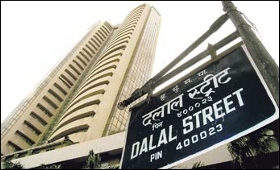|

|
Falling Asian markets, macro data drowns Sensex
|
|

|
|
| Top Stories |
 |
|
|
|
SME Times News Bureau | 01 Sep, 2015
The slide in Asian markets, especially the continuous rout in Chinese
bourses and below-expected macro data sobered investor's sentiments and
sent the Indian equities markets plunging on Tuesday.
The barometer 30-scrip sensitive index (Sensex) of the Bombay Stock Exchange (BSE)
tanked by 586.65 points or 2.23 percent at 25,696.44 points.
Bearish
sentiments were also witnessed at the wider 50-scrip Nifty of the
National Stock Exchange (NSE). It ended the day's trade at 185.45 points
or 2.33 percent down at 7,785.85 points.
The S&P BSE Sensex
which opened at 26,127.04 points, closed at 25,696.44 points, down
586.65 points or 2.23 percent from the previous day's close at 26,283.09
points.
The Sensex touched a high of 26,141.07 points and a low of 25,579.88 points during the intra-day trade.
Analysts
cited negative cues eminating out of Asian markets, especially the
continuous slide in the Chinese exchanges to be the catalyst for the
sharp fall in the domestic bourse.
"The sharp fall in the day's
trade and the high intra-day volatility were caused due to the bearish
cues coming in from the Asian markets. The investors are nervous about
the evolving situation in China and its apparent outcome which might be a
bigger challenge in the long run," Anand James, co-head, technical
research, Geojit BNP Paribas, told IANS.
"The volatility is also
being flared-up due to expectations of new measures by the Chinese
government and central bank to stabilise the markets. This might put
further pressure on the yuan and subsequently on the rupee value."
Among
the Asian markets, Japan's Nikkei plunged by 3.84 percent. Hong Kong's
Hang Seng plummet by 2.24 percent. China's Shanghai Composite Index
dropped by 1.28 percent.
The massive implosion in the Chinese
markets which has by some estimates eroded 40-45 percent of the entire
stock value coupled with yuan devaluation and lower factory out has
spooked the world markets.
Other factors which subdued the
markets were below-expected first quarter (Q1) gross domestic product
(GDP), eight core industries (ECI) and purchasing mangers index (PMI)
figures. All these macro data points were below market's estimates.
"Markets
are seeing a significant fall today led by the lower than expected GDP
growth and a global selloff on account of the weak Chinese PMI figures,
which slipped below the 50-mark in August indicating a contraction,"
Vaibhav Agrawal, vice president, research, Angel Broking told IANS.
The
Q1 GDP came in at 7 percent, showing signs of slowing vis-a-vis the 7.5
percent expansion in the quarter before. But the growth was much higher
than 6.7 percent registered in the first quarter of the last fiscal.
The
ECI for select factory output slowed to 1.1 percent growth in July from
an increase of 3 percent in the previous month, mainly due to a fall in
steel production and marginal growth in coal. The select factory output
index rose by 4.1 percent in July 2014.
The Nikkei India
Manufacturing PMI (Purchasing Manufacturers Index) for the last month
stood at 52.3 which is marginally down from July's 52.7.
An index reading of above 50 indicates an overall increase in the manufacturing sector, below 50 an overall decrease.
"Market
shut the day with severe cuts on the back of weak global and domestic
macro economic data. China’s weak PMI and India’s lower GDP growth
dampened the sentiments. Sell-off was mainly triggered by the banks
especially PSU banks on raising the concerns of pressure on their
margins," said Gaurav Jain, director with Hem Securities.
Sector-wise,
all 12 sub-indices of the BSE ended the day's trade in the red. The
S&P BSE banking, automobile, capital goods, consumer durables and
healthcare indices came under intense selling pressure.
The
S&P BSE banking index plunged by 713.55 points, the automobile index
receded by 472.84 points, the capital goods index contracted by 442.05
points, the consumer durables index declined by 272.67 points and
healthcare index decreased by 263.78 points.
Major Sensex gainers during Tuesday's trade were: Sun Pharma, up 0.34 percent at Rs.900.75.
The
major Sensex losers were: Axis Bank, down 5.24 percent at Rs.480.15;
Hindalco Industries, down 5.18 percent at Rs.75.90; Tata Steel, down
3.93 percent at Rs.216.20; BHEL, down 3.91 percent at Rs.217.65; and
Vedanta, down 3.80 percent at Rs.94.85.
In Europe, London's FTSE
100 index rose by 0.90 percent, French CAC 40 tumbled by 0.50 percent
and Germany's DAX Index slipped by 0.43 percent at close of trading
here.
|
|
|
| |
|
|
|
|
|
|
|
|
|
|
|
|
|
|
| |
| Customs Exchange Rates |
| Currency |
Import |
Export |
US Dollar
|
66.20
|
64.50 |
UK Pound
|
87.50
|
84.65 |
Euro
|
78.25
|
75.65 |
| Japanese
Yen |
58.85 |
56.85 |
| As on 13 Aug, 2022 |
|
|
| Daily Poll |
 |
 |
| PM Modi's recent US visit to redefine India-US bilateral relations |
|
|
|
|
|
| Commented Stories |
 |
|
|
|
|
|
| |
|